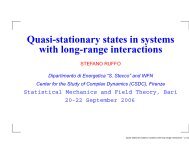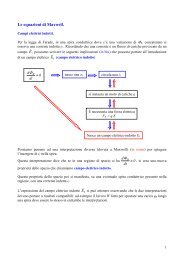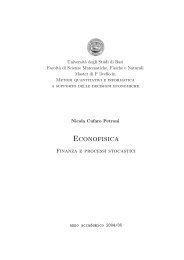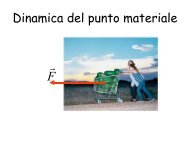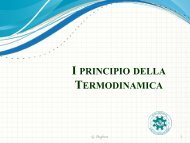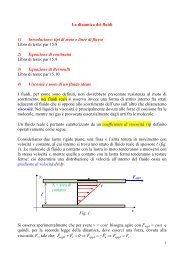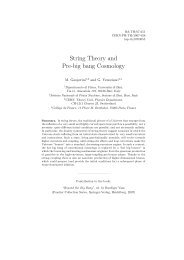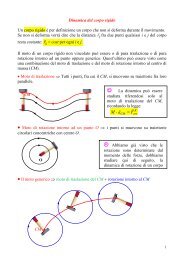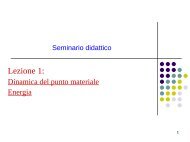Pricing and Hedging Asian Basket Options with Quasi-Monte ... - Infn
Pricing and Hedging Asian Basket Options with Quasi-Monte ... - Infn
Pricing and Hedging Asian Basket Options with Quasi-Monte ... - Infn
Create successful ePaper yourself
Turn your PDF publications into a flip-book with our unique Google optimized e-Paper software.
Methodol Comput Appl ProbabDOI 10.1007/s11009-011-9228-9<strong>Pricing</strong> <strong>and</strong> <strong>Hedging</strong> <strong>Asian</strong> <strong>Basket</strong> <strong>Options</strong><strong>with</strong> <strong>Quasi</strong>-<strong>Monte</strong> Carlo SimulationsNicola Cufaro Petroni · Piergiacomo SabinoReceived: 11 September 2009 / Revised: 27 February 2011 /Accepted: 2 May 2011© Springer Science+Business Media, LLC 2011Abstract In this article we consider the problem of pricing <strong>and</strong> hedging highdimensional<strong>Asian</strong> basket options by <strong>Quasi</strong>-<strong>Monte</strong> Carlo simulations. We assumea Black–Scholes market <strong>with</strong> time-dependent volatilities, <strong>and</strong> we compute the deltasby means of the Malliavin Calculus as an extension of the procedures employedby Kohatsu-Higa <strong>and</strong> <strong>Monte</strong>ro (Physica A 320:548–570, 2003). Efficient pathgenerationalgorithms, such as Linear Transformation <strong>and</strong> Principal ComponentAnalysis, exhibit a high computational cost in a market <strong>with</strong> time-dependent volatilities.To face this challenge we then introduce a new <strong>and</strong> faster Cholesky algorithmfor block matrices that makes the Linear Transformation more convenient. We alsopropose a new-path generation technique based on a Kronecker Product Approximation.Our procedure shows the same accuracy as the Linear Transformation usedfor the computation of deltas <strong>and</strong> prices in the case of correlated asset returns, whilerequiring a shorter computational time. All these techniques can be easily employedfor stochastic volatility models based on the mixture of multi-dimensional dynamicsintroduced by Brigo et al. (2004a, Risk 17(5):97–101, b).Keywords Computational finance · <strong>Quasi</strong>-<strong>Monte</strong> Carlo algorithms ·Malliavin Calculus · <strong>Pricing</strong> <strong>and</strong> hedging options · <strong>Asian</strong> basket optionsAMS 2000 Subject Classification 91G60N. Cufaro PetroniDipartimento di Matematica <strong>and</strong> TIRES, Università di Bari,INFN Sezione di Bari, via E. Orabona 4, 70125 Bari, Italye-mail: cufaro@ba.infn.itP. Sabino (B)Dipartimento di Matematica, Università di Bari, via E. Orabona 4, 70125 Bari, Italye-mail: sabino@dm.uniba.itP. SabinoE.ON Energy Trading SE, Holzstrasse 6, 40221 Düsseldorf, Germanye-mail: piergiacomo.sabino@eon.com
Methodol Comput Appl Probab1 Introduction <strong>and</strong> MotivationIn a few recent papers Dahl <strong>and</strong> Benth (2002) <strong>and</strong> Wang (2009) have investigatedthe efficiency <strong>and</strong> the computational cost of the Principal Component Analysis(PCA) used in the <strong>Quasi</strong>-<strong>Monte</strong> Carlo (QMC) simulations for the pricing of highdimensional<strong>Asian</strong> basket options in a multi-dimensional Black–Scholes (BS) model<strong>with</strong> constant volatilities. In particular they have shown the essential role of theKronecker product both for a fast implementation, <strong>and</strong> for identifying the effectivedimension in the analysis of variance (ANOVA, see below). Since the convergencerate of the QMC method is O ( N −1 log d N ) —here N is the number of simulationtrials, <strong>and</strong> d the nominal dimension of the problem—the theoretically higher asymptoticconvergence rate of QMC could not be practically achieved in high dimensions.On the other h<strong>and</strong>, particular applications in finance (see Paskov <strong>and</strong> Traub 1995)have shown that the QMC provides an accuracy higher than the st<strong>and</strong>ard <strong>Monte</strong>Carlo (MC) even for high dimensions.To explain the success of the QMC in high dimensions Caflisch et al. (1997)have introduced two notions of effective dimensions based on the ANOVA ofthe integr<strong>and</strong> function. Consider an integr<strong>and</strong> function f for a MC problem <strong>with</strong>nominal dimension d,<strong>and</strong>letA ={1,...,d} denote the labels of the input variablesof the function f : the effective dimension of f in the superposition sense is thesmallest integer d S such that ∑ |u|≤d Sσ 2 ( f u ) ≥ pσ 2 ( f ), where f u is a function <strong>with</strong>variables in the set u ⊆ A , σ 2 (·) denotes the variance of the given function, |u| is thecardinality of the set <strong>and</strong> 0 ≤ p ≤ 1 (for instance p = 0.99). On the other h<strong>and</strong> theeffective dimension of f in the truncation sense is the smallest integer d T such that∑u⊆{1,2,...,d T } σ 2 ( f u ) = pσ 2 ( f ). In other words the truncation dimension indicates thenumber of variables essential to capture the given function f , while the superpositiondimension takes into account that, for some f ’s, the inputs might influence theoutcome through their joint action <strong>with</strong>in smaller groups.Different techniques have been proposed for a dimension reduction: the PCAdecomposition <strong>and</strong> the Brownian bridge (BB) however achieve this result independentlyfrom the particular payoff of a European option. Imai <strong>and</strong> Tan (2006) haveinstead proposed a general dimension reduction construction, the Linear Transformation(LT), that depends on the payoff function, <strong>and</strong> that minimizes the effectivedimension in the truncation sense. Several studies have investigated the efficiency ofthe dimension reduction produced by these approaches. Wang (2009), for example,has shown that the accuracy of the QMC simulations depends on both the dimensionreduction technique, <strong>and</strong> the quasi-r<strong>and</strong>om points. He also proved that the PCAdecomposition is always outperforming the BB as a result of the different groupingstrategies developed (see the cited article for more details). Moreover, Papageorgiou(2002) has demonstrated that the accuracy of the QMC method used for thepricing of certain specific derivative contracts is not substantially improved by aBB construction. Finally Imai <strong>and</strong> Tan (2006) have shown that the LT approachis more accurate than the st<strong>and</strong>ard PCA <strong>and</strong> BB, but has a higher computationalcost. In a previous paper one of the authors (Sabino 2011) has described how toefficiently implement this technique <strong>and</strong>, even <strong>with</strong> a slower computer, has obtainedcomputational times that are about 30 times shorter than those originally presentedby Imai <strong>and</strong> Tan (2006).In the present paper we address the problem of the time-dependent volatilities,<strong>and</strong> since we can no longer rely on the properties of the Kronecker product, our task
Methodol Comput Appl Probabwill be computationally harder. In order to reduce this computational complexity,we first introduce a fast Cholesky (CH) decomposition algorithm tailored for blockmatrices: this will already severely lower the computational cost. Then we presenta new path-generation technique based on the Kronecker Product Approximation(KPA) of the correlation matrix of a multi-dimensional Brownian path: this returnsa suboptimal ANOVA decomposition <strong>with</strong> a remarkable computational advance.In the case of time-dependent volatilities, the BB procedure also requires a slightlydifferent algorithm (see Sabino 2009 for details), but on the basis of the previousobservations we have decided not to include it in this study.Our numerical simulations consist first in calculating the R<strong>and</strong>omized QMC(RQMC) estimation of both the prices <strong>and</strong> the deltas of high-dimensional <strong>Asian</strong>basket options in a BS market <strong>with</strong> time-dependent volatilities. In order to computethe deltas we extend to a dependent multi-assets model the procedure employedby Kohatsu-Higa <strong>and</strong> <strong>Monte</strong>ro (2003) in a single-asset setting. To do that we takeadvantage of the Malliavin Calculus, <strong>and</strong> we allow a certain flexibility to enhance thelocalization techniques introduced by Fournié et al. (1999). As far as the computationof the <strong>Asian</strong> options prices is concerned, the KPA <strong>and</strong> LT approaches are checkedboth in terms of accuracy <strong>and</strong> computational cost. We show that the LT procedure ismore efficient than the PCA—even from a computational point of view—providedthat we adopt our CH algorithm <strong>and</strong> the approach described in Sabino (2011). TheKPA <strong>and</strong> the PCA constructions perform equally well in terms of accuracy, but<strong>with</strong> the former requiring a considerably shorter computational time. In the samevein, the KPA <strong>and</strong> the LT display comparable accuracies in the computation of thedeltas. Finally we contrast our simulations—also using the st<strong>and</strong>ard CH <strong>and</strong> the PCAdecomposition methods—<strong>with</strong> both pseudo-r<strong>and</strong>om <strong>and</strong> Latin Hypercube Sampling(LHS) generators.We finally remark that all the methods described here can accommodate a market<strong>with</strong> stochastic volatility where the evolution of the risky securities is modeled by amixture of multi-dimensional dynamics as in the papers by Brigo et al. (2004a, b). Itis noteworthy to say instead that none of these procedures can be applied to theHeston-like multi-dimensional stochastic volatility models. In principle we mightstill use the LT for the Euler discretization of the Heston model, but this couldbe no longer applicable <strong>with</strong>in more realistic frameworks involving discrete r<strong>and</strong>omvariables as proposed for instance by Alfonsi (2005).The paper is organized as follows: the Section 2 describes <strong>Asian</strong> options, while theSection 3 discusses some path-generation techniques <strong>and</strong> in particular, presents thefast CH algorithm <strong>and</strong> the KPA construction. Section 4 shows then the numericalsimulations for the <strong>Asian</strong> option pricing, <strong>and</strong> Section 5 explains how to represent thedeltas of <strong>Asian</strong> basket options as expected values <strong>with</strong> the aid of Malliavin Calculus,<strong>and</strong> shows their estimated values by RQMC. Section 6 finally summarizes the mostimportant results <strong>and</strong> concludes the paper.2 <strong>Asian</strong> <strong>Basket</strong> <strong>Options</strong>Assume a multi-dimensional BS market <strong>with</strong> M risky securities <strong>and</strong> one riskfreeasset. Denote B (t) = (B 1 (t) ,...,B M (t)) an M-dimensional Brownian motion(BM) <strong>with</strong> correlated components <strong>and</strong> (F t ) t≥0 the filtration generated by this BM.
Methodol Comput Appl ProbabMoreover, denote ρ ik the constant instantaneous correlation between B i (t) <strong>and</strong>B k (t), S i (t) the i-th asset price at time t, σ i (t) the instantaneous time-dependentvolatility of the i-th asset return <strong>and</strong> r the continuously compounded risk-free rate.In the risk-neutral probability, we assume that the dynamics of the risky assets aredS i (t) = rS i (t) dt + σ i (t) S i (t) dB i (t) , i = 1,...,M. (1)The solution of Eq. 1 is[∫ tS i (t) = S i (0) exp(r − σ 20i(s)2)ds +∫ t0]σ i (s) dB i (s) , i = 1, ..., M. (2)Discretely monitored <strong>Asian</strong> basket options are derivative contracts that dependon the arithmetic mean of the prices assumed by a linear combination of theunderlying securities at precise times t 1 < t 2 ···< t N = T, whereT is the maturityof the contract. By the risk-neutral pricing formula (see for instance Lamberton <strong>and</strong>Lapeyre 1996) the fair price of the contract at time t is⎡⎛⎞M∑ N∑a (t) = e r(T−t) ( ) + ⎤∣ ∣∣∣E ⎣⎝w ij S i t j − K ⎠ F t⎦ , (3)i=1j=1<strong>with</strong> the assumption that ∑ i, j w ij = 1.<strong>Pricing</strong> <strong>Asian</strong> options by simulation hence requires the discrete averaging of thesolution (2)atafinitesetoftimes{t 1 ,...,t N }. This sampling procedure yields[ ∫ t jS i (t j ) = S i (0) exp(r − σ 20i (t)2where the components of the vector)dt + Z i (t j )]i = 1,...,M, j = 1,...,N, (4)(Z 1 (t 1 ),...,Z 1 (t N ); Z 2 (t 1 ),...,Z 2 (t N ); ...; Z M (t 1 ),...,Z M (t N )) Tare M × N normal r<strong>and</strong>om variables <strong>with</strong> zero mean <strong>and</strong> the following covariancematrix⎛⎞(t 1 )(t 1 )... (t 1 )(t 1 )(t 2 )... (t 2 ) MN = ⎜⎝... ... ..⎟⎠ , (5)(t 1 )(t 2 )...(t N )∫where the elements of the M × M submatrices (t n ) are ((t n )) ik =tn0 ρ ikσ i (s)σ k (s)ds <strong>with</strong> i, k = 1,...,M; n = 1,...,N. This setting is also suitablefor time-dependent correlations. In the case of constant volatilities the covariancematrix is⎛⎞t 1 t 1 ...t 1 t 1 t 2 ...t 2 MN = ⎜⎝... ... ..⎟⎠ , (6)t 1 t 2 ...t N where now denotes the M × M covariance matrix of the logarithmic returns ofthe assets. It follows from the last equation that the covariance matrix MN can be
Methodol Comput Appl Probabrepresented as R ⊗ , where⊗ denotes the Kronecker product <strong>and</strong> R is the autocovariancematrix of a single BM. This simplification is not possible in the case oftime-dependent volatilities. We recall that the elements of R areR ln = t l ∧ t n , l, n = 1,...N, (7)<strong>and</strong> that R is invariant under reflections about the diagonal.Definition 1 (Boomerang Matrix) The square matrix B ∈ R nB×nBmatrix if it exists a vector b = ( )b 1 ,...,b nB ∈ Rn Bsuch thatis a boomerangB hp = b h∧p , h, p = 1,...,n B . (8)In this case b takes the name of elementary vector associated to B.As a consequence R is boomerang, <strong>and</strong> in general the auto-covariance matrix ofevery Gaussian process is boomerang. This definition can also be extended to blockmatrices as follows.Definition 2 (Block Boomerang Matrix) Partition the rows <strong>and</strong> the columns of asquare matrix B ∈ R nB×nB to obtain:⎛⎞B 11 ... B 1P⎜B =⎝.. ... ..⎟⎠ , (9)B P1 ... B PPwhere for h, p = 1,...,P, B hp ∈ R D×D designates the (h, p) square submatrix <strong>and</strong>n B = P × D; thenB is a boomerang block matrix if we can find P matrices B 1 ,...,B P <strong>with</strong> B h ∈ R D×D , h = 1,...,P such thatB hp = B h∧p , h, p = 1,...,n B . (10)The vector b = (B 1 ,...,B P ) T takes the name of elementary block vector associatedto B.From these definitions we find that MN is block boomerang.The payoff at maturity of the <strong>Asian</strong> basket option now is a(T) = (g(Z) − K) + <strong>with</strong>where Z ∼ N (0, MN ) <strong>and</strong>g(Z) =M×N∑k=1exp (μ k + Z k ) (11)∫ tk2σk 2 μ k = ln(w k1k 2S k1 (0)) + rt k2 −1(t)dt (12)0 2<strong>with</strong> k 1 = (k − 1) mod M; k 2 =⌊(k − 1)/M⌋+1; k = 1,...,M, where⌊x⌋ denotesthe greatest integer less than or equal to x.
Methodol Comput Appl Probab3 Path-Generation TechniquesFrom the previous discussion it comes out that the pricing of <strong>Asian</strong> basket optionsby simulation requires an averaging on the sample trajectories of an M-dimensionalBM. In general, if Y ∼ N (0, Y ) <strong>and</strong> X ∼ N (0, I) are two N-dimensional Gaussianr<strong>and</strong>om vectors, we will always be able to write Y = CX, whereC is a matrixsuch that: Y = CC T . (13)<strong>and</strong> the core problem consists in finding the matrix C. Inourcase Y coincides <strong>with</strong> MN of Eq. 5. The accuracy of the st<strong>and</strong>ard MC method does not depend on thechoice of the matrix C because the order of the r<strong>and</strong>om variables is not important.However, a choice of C that reduces the nominal dimension would improve theefficiency of the (R)QMC method, <strong>and</strong> in the following we discuss a few possiblecases.3.1 Cholesky ConstructionThe CH decomposition simply finds the matrix C among all the lower triangularmatrices. In the case of constant volatilities the matrix MN is the Kronecker productof R <strong>and</strong> , <strong>and</strong> the Kronecker product is compatibile <strong>with</strong> a CH decomposition (seePitsianis <strong>and</strong> Van Loan 1993). In fact, denoting by C MN , C R <strong>and</strong> C the CH matricesassociated to MN , R <strong>and</strong> respectively, we haveC MN = C R ⊗ C . (14)This now entails a remarkable reduction of the computational cost: it turns outindeed that a O ( (M × N) 3) computation is reduced to a O ( M 3) + O ( N 3) one.When time-dependent volatilities are considered, however, we can no longer usethese properties of the Kronecker product: in their stead, since MN is a blockboomerang matrix, we can take advantage of the following result:Proposition 1 Let B ∈ R nB×nB be a block boomerang matrix <strong>and</strong> let (B 1 ,...,B P ) T ,where B h ∈ R D×D , h = 1,...,P <strong>with</strong> n B = P × D, be its associated elementary blockvector. Then the CH matrix C B associated to B is⎛⎞C 1 0 ... 0.C B =. C .. 2 0⎜⎝... ... ⎟(15).. ⎠C 1 C 2 ... C Pwhere the D × DblocksC h ,h= 1,...,PareC h = Chol (B h − B h−1 ) (16)<strong>with</strong> Chol denoting the CH factorization. We also assume B 0 = 0.
Methodol Comput Appl ProbabProof Consider the h th row of C B <strong>and</strong> the m th row of its transposed matrix; wethen have(C 1 ,...,C h , 0,...,0) T · (C h∧m1 T ,...,CT m , 0,...,0) T∑= C l ClTl=1h∧m∑= (B l − B l−1 ) = B h∧ml=1<strong>and</strong> this concludes the proof.⊓⊔3.2 Principal Component AnalysisAcworth et al. (1998) have proposed a path generation technique based on the PCA.Following this approach we consider the spectral decomposition of MN MN = EE T = ( E 1/2)( E 1/2) T, (17)where is the diagonal matrix of all the positive eigenvalues of MN sorted indecreasing order <strong>and</strong> E is the orthogonal matrix (EE T = I) of all the associatedeigenvectors. The matrix C solving Eq. 13 then is E 1/2 . The amount of variance∑ ki=1explained by the first k principal components is the ratio: ∑ λid where d is the ranki=1 λiof MN . The PCA construction permits the statistical ranking of the normal factors,while this is not possible by the CH decomposition. For a market <strong>with</strong> constantvolatilities, the Kronecker product reduces this calculation to the computation ofeigenvalues <strong>and</strong> eigenvectors of the two smaller matrices R <strong>and</strong> . All these simplifications,on the other h<strong>and</strong>, are no longer valid for the time-dependent volatilities.Nevertheless we can still reduce the computational cost of a PCA decomposition ina different way.Let M 1 , M 2 , M 3 <strong>and</strong> M 4 be respectively p × p, p × q, q × p <strong>and</strong> q × q matrices,<strong>and</strong> suppose that M 1 <strong>and</strong> M 4 are invertible. Assume then( )M1 MM =2M 3 M 4<strong>and</strong> define S 1 = M 4 − M 3 M −11 M 2 <strong>and</strong> S 4 = M 1 − M 2 M −14 M 3, namely the Schurcomplements of M 1 <strong>and</strong> M 4 respectively. Then by Schur’s lemma the inverse M −1 is:(M −1 S= 4 −M −11 M 2S −1 )1−M −14 S−1 4S −1 . (18)1Taking into account the previous result it is possible to prove the followingpropositionProposition 2 Let B ∈ R nB×nB be a block boomerang matrix, <strong>and</strong> (B 1 ,...,B P ) T —where B h ∈ R D×D , h = 1,...,P <strong>with</strong> n B = P × D—its associated elementary blockvector: then the inverse of B is symmetric block tri-diagonal. The blocks on the lower(<strong>and</strong> upper) diagonal are T l =−(B l+1 − B l ) −1 ,l= 1,...,P − 1 while those on the
Methodol Comput Appl ProbabImai <strong>and</strong> Tan (2006) have then proved the following result:Proposition 3 Consider an <strong>Asian</strong> basket options in a BS model, <strong>and</strong> def ine( (d (p) μ ∑ ) (p−1= e 1+ k=1 C∗ 1kμ ∑ ))p−1 T,...,eMN+k=1 C∗ MN,k(24)B (p) = ( C Ch) T(d (p) ), p = 1,...,MN. (25)Then the p-th column of the optimal matrix A ∗ isB(p)A∗·p =±‖B (p) ‖p = 1,...,MN. (26)The matrices Cik ∗ , k < p have already been found in the previous p − 1 steps, whileA·p must be orthogonal to all the other columns. This condition can be easily met byan incremental QR decomposition, as described in Sabino (2011).3.4 Kronecker Product ApproximationIn a time-dependent volatility market the covariance matrix MN has timedependentblocks. The multi-dimensional BM is the unique source of risk in the BSmarket <strong>and</strong> the generation of the trajectories of the 1-dimensional BM does dependon the volatilities. As a consequence we propose to find a constant covariance matrixof the assets H in order to approximate, in an appropriate sense, the matrix MNas a Kronecker product of R <strong>and</strong> H. In the following we illustrate the proposedprocedure called Kronecker Product Approximation (KPA). Pitsianis <strong>and</strong> Van Loan(1993) have proved the following proposition:Proposition 4 Suppose G ∈ R m×n <strong>and</strong> G 1 ∈ R m1×n1 <strong>with</strong> m = m 1 m 2 <strong>and</strong> n = n 1 n 2 .Consider the problem of f inding G ∗ 2 ∈ Rm1×n1 that realizes the minimummin ‖ G − G 1 ⊗ G 2 ‖ 2 F , (27)G 2∈R m 1 ×n 1where ‖·‖ 2 F denotes the Frobenius norm. For f ixed h = 1,...,m 2 <strong>and</strong> l = 1,...,n 2denote R(G) hl the m 1 × n 1 matrix def ined by the rows h, h + m 2 , h + 2m 2 ,...,h +(m 1 − 1)m 2 <strong>and</strong> the columns l, l + n 2 , l + 2n 2 ,...,l + (n 1 − 1)n 2 of the original matrixG. The elements of G ∗ 2then are(G ∗ 2 ) hl = Tr ( R(G)hl T G )1Tr ( )G 1 G1T h = 1,...,m 2 , l = 1,...,n 2 , (28)where Tr denotes the trace of a matrix.In our setting we have G = MN , G 1 = R <strong>and</strong> G 2 = H, <strong>and</strong> we remark that for anyi, j = 1,...,N, R( MN )) ij is a N × N boomerang matrix. Moreover, given two generalN × N boomerang matrices A <strong>and</strong> B, we can prove by direct computation thatTr(A T B) = Tr(AB) =N∑(2(N − j) + 1) a jj b jj . (29)j=1
Methodol Comput Appl ProbabWe then perform the PCA decomposition of R ⊗ H by relying on the propertiesof the Kronecker product, but, if we use the PCA decomposition of the matrixF = R ⊗ H, we do not get the required path. In order to produce the requiredtrajectory we then takeZ = C KPA ε = C MN (C F ) −1 E H 1/2H ε (30)where C MN <strong>and</strong> C F are the CH matrices associated to MN <strong>and</strong> F, respectively, <strong>and</strong>E H 1/2His the PCA decomposition of F: thematrixCKPA turns out to be the correctcovariance matrix because, denoting P = E H 1/2H, we haveC KPA ( C KPA) T= CMN (C F ) −1 PP T [ (C F ) −1] TCTMN= C MN C T MN= MNsince PP T = C F C T F= F. Our fundamental assumption is here that the principalcomponents of Z are not too different from those of the normal r<strong>and</strong>om vectorZ ′ whose covariance matrix is F. We expect that the KPA decompositionwould produce an effective dimension higher than that obtained by the PCAdecomposition, but <strong>with</strong> a substantial boon from the computational st<strong>and</strong>point. Dueto properties of the Kronecker product, indeed, the Eq. 30 becomes(Z = C MN C−1R⊗ ) C−1 H EH 1/2Hε, (31)where C R <strong>and</strong> C H are the CH matrices of R <strong>and</strong> H, respectively, <strong>and</strong> this matrixmultiplication can be carried out quickly by block-matrices multiplication <strong>and</strong>taking advantage of the fact that (due to the Propositions 1 <strong>and</strong> 2) C −1Ris a sparsebi-diagonal matrix.4 Computing the Option PriceWe will now estimate the fair price of an <strong>Asian</strong> option on a basket of M = 10 underlyingassets <strong>with</strong> N = 250 sampled points in the BS model, <strong>with</strong> time-dependentvolatilities having the following expressionσ i (t) =ˆσ i (0) exp (−t/τ i ) + σ i (+∞), i = 1,...M. (32)The parameters chosen for the simulation are listed in Table 1, <strong>and</strong> of course we haveˆσ i (0) = σ i (0) − σ i (+∞). We implement this numerical investigation in two steps:first we test the effectiveness of our path-generation procedures on the dimensionreduction <strong>and</strong> compute their computational times; then we compare the accuracy ofthe simulations.Table 1 Inputs parametersS i (0) = 100, ∀i = 1 ...,NK = 100r = 4%T = 1σ i (0) = 10% + i−19 40% i = 1 ...,Nσ i (+∞) = 9% ∀i = 1 ...,Nτ i = 1.5 ∀i = 1 ...,Nρ ij ⊂{0, 40} i, j = 1 ...,N
Methodol Comput Appl ProbabTable 2 Effective dimensionsCh PCA LT KPATime-dependent volatilitiesρ = 0%d T > 1900 d T = 14 d T = 10 d T = 19ρ = 40%d T > 1900 d T = 9 d T = 8 d T = 11Table 2 shows the effective dimensions obtained by the different the pathgenerationmethods considered (p = 0.99). The LT construction provides the lowesteffective dimension, while the PCA decomposition performs almost as well as the LTapproach only for the correlation case, <strong>and</strong> the KPA returns a slightly higher effectivedimension. The CH decomposition collects 98.58% <strong>and</strong> 98.70% of the total variancefor d T ≈ 2000, respectively in the uncorrelated <strong>and</strong> in the correlated cases. To havea more detailed comparison look at the Table 3 which displays the elapsed timesmeasured in Sabino (2011)byusinganad hoc incremental QR algorithm for the LT,<strong>and</strong> assuming constant volatilities equal to the σ i (0) of Table 1. The computationwas implemented in MATLAB running on a laptop <strong>with</strong> an Intel Pentium M,processor 1.60 GHz <strong>and</strong> 1 GB of RAM. We computed 50 optimal columns for theLT technique. The CH algorithm for block boomerang matrices has almost the samecost as the one relying on the properties of the Kronecker product. As a consequencethe LT also requires almost the same computational cost, while the PCA needs atime almost 20 times longer because now we can not rely on the properties of theKronecker product. In contrast, the KPA has almost the same computational time asthe PCA in the constant volatility case, <strong>and</strong> is the best performing path-generationprocedure from a computational time point of view. We have applied Proposition 2to implement the PCA, <strong>and</strong> we have computed the eigenvalues <strong>and</strong> eigenvectorsof MN relying only on the sparse function of MATLAB. The development ofalgorithms tailored for the computation of the eigenvalues <strong>and</strong> eigenvectors of tridiagonalsymmetric block matrices is still in progress: hopefully they could furtherreduce the computational time <strong>and</strong> their performance will be presented in futurepapers.In the second part of our investigation we launched a simulation to estimate the<strong>Asian</strong> option price using 10 replications, each consisting in 8192 r<strong>and</strong>om points,following the strategy in Imai <strong>and</strong> Tan (2006). We used again different r<strong>and</strong>om generators:st<strong>and</strong>ard MC, LHS <strong>and</strong> RQMC generators. Concerning the computationaltimes of the price estimation, the CPU ratio between LHS <strong>and</strong> RQMC is almost 1Table 3 Computational timesin secondsCh PCA LT KPAConstant volatilitiesρ = 0%0.60 25.77 71.14ρ = 40%0.59 25.55 71.02Time-dependent volatilitiesρ = 0%0.62 565.77 71.65 28.25ρ = 40%0.62 568.55 71.20 28.33
Methodol Comput Appl Probabwhile st<strong>and</strong>ard MC is 1.33 faster. As suggested in Glasserman (2004), we consideredboth the product of the root mean square error (RMSE), <strong>and</strong> the square root ofthe total computational time of the simulation as a measure of total accuracy of thesimulation. We denote this latter quantity as Err.We used a Matouŝek affine plus r<strong>and</strong>om digital shift scrambled version (seeMatouŝek 1998) of the Sobol sequence satisfying Sobol’s property A (see Sobol1976), <strong>and</strong> we also shunned generating a 2,500-dimensional Sobol’ sequence byusing the Latin Supercube Sampling (LSS) method (Owen 1998). Briefly speakingthis sampling procedure is a scheme for producing high-dimensional sequences outfrom sets of lower-dimensional sequences. For instance, a 2,500-dimensional lowdiscrepancy sequence can be concatenated from 100 sets of 25-dimensional lowdiscrepancy sequences by suitably r<strong>and</strong>omizing the run order of the points. For atheoretical justification of the LSS method, see Owen (1998).LHS can also be seen as an intermediate solution between pseudo- <strong>and</strong> quasir<strong>and</strong>ompoints in terms of accuracy enhancement by stratification. It can be provedindeed that LHS gives good variance reductions when the target function is the sumof one-dimensional functions (see Stein 1987). On the other h<strong>and</strong>, the LT methodis designed to capture the lower effective dimension in the truncation sense forlinear combinations. As a consequence we should have a high accuracy when justrunning the simulation using a combination of LHS <strong>and</strong> LT. We expect that theKPA technique produces a suboptimal decomposition in the sense of ANOVA,<strong>with</strong> the advantage of a lower computational effort. Our setting is organized tocheck how large the improvement given by every factorization is. Tables 4 <strong>and</strong> 5present the results of this investigation. The prices in Table 4 are all in statisticalagreement. Those obtained <strong>with</strong> the CH decomposition are almost independent fromthe r<strong>and</strong>om number generator: KPA, PCA <strong>and</strong> LT all provide good improvements inboth the LHS <strong>and</strong> RQMC implementations for all the strike prices. The LT, however,has an apparent advantage <strong>with</strong> respect to PCA <strong>and</strong> KPA, <strong>and</strong> this is still moreconspicuous in the uncorrelated case. In contrast, we observe that the KPA- <strong>and</strong>PCA-based simulations give almost the same accuracy, assuming both correlated <strong>and</strong>uncorrelated asset returns. Considering the total computational cost <strong>and</strong> the accuracywe remark that the KPA performs better than the st<strong>and</strong>ard PCA. Moreover, all theseTable 4 Estimated at-the money prices <strong>and</strong> errorsρ = 0% ρ = 40%Price Err Price ErrMC Ch 3.180 0.700 5.190 1.400KPA 3.120 0.700 5.190 1.410PCA 3.110 0.750 5.200 1.490LT 3.110 0.710 5.210 1.420LHS Ch 3.120 0.420 5.200 0.680KPA 3.120 0.310 5.201 0.190PCA 3.120 0.330 5.201 0.200LT 3.120 0.170 5.201 0.069RQMC Ch 3.112 0.410 5.195 0.500KPA 3.122 0.047 5.201 0.033PCA 3.121 0.053 5.201 0.040LT 3.122 0.018 5.201 0.019
Methodol Comput Appl ProbabTable 5 At-the-money estimated ’s (10 −2 ) <strong>and</strong> errors (10 −4 )<strong>with</strong>RQMCLT KPA PCA CH Err Err Err Errρ = 0%6.18 0.43 6.18 0.60 6.18 0.51 6.21 0.826.20 0.40 6.21 0.49 6.20 0.51 6.23 0.606.23 0.46 6.23 0.47 6.23 0.58 6.25 0.656.27 0.40 6.27 0.44 6.27 0.54 6.28 0.766.31 0.32 6.31 0.50 6.31 0.57 6.33 0.656.36 0.30 6.36 0.52 6.36 0.49 6.38 0.606.41 0.27 6.41 0.50 6.41 0.46 6.43 0.656.47 0.27 6.47 0.49 6.47 0.49 6.49 0.766.53 0.27 6.54 0.50 6.53 0.55 6.55 0.716.60 0.35 6.61 0.42 6.60 0.57 6.61 0.60ρ = 40%5.478 0.030 5.484 0.060 5.481 0.077 5.468 0.5995.535 0.033 5.541 0.060 5.537 0.082 5.525 0.6545.594 0.029 5.600 0.060 5.597 0.077 5.587 0.6545.654 0.033 5.661 0.065 5.657 0.077 5.640 0.5455.717 0.040 5.723 0.070 5.718 0.082 5.710 0.5995.781 0.044 5.789 0.065 5.784 0.071 5.770 0.7085.848 0.041 5.853 0.052 5.851 0.071 5.832 0.6545.916 0.044 5.921 0.060 5.918 0.077 5.900 0.5995.985 0.028 5.991 0.050 5.987 0.071 5.971 0.5456.055 0.032 6.061 0.060 6.057 0.077 6.046 0.654constructions can be employed in stochastic <strong>and</strong> local volatility models based on themixture of multi-dimensional dynamics for basket options, as done in Brigo et al.(2004a).5 Computing the SensitivitiesIn the financial jargon a Greek is the derivative of an option price <strong>with</strong> respect toa parameter, <strong>and</strong> hence represents a measure of the price sensitivity <strong>with</strong> respect tothat parameter. The deltas (’s) in particular are the components of the gradientof the discounted expected outcome of the option <strong>with</strong> respect to the initial valuesof the assets. The problem of computing the Greeks in finance has been studied byseveral authors: here we extend the methodology employed by Kohatsu-Higa <strong>and</strong><strong>Monte</strong>ro (2003), based on the use of Malliavin Calculus, to the multi-assets case. Themain difficulties of this extension lie in the fact that the assets are now correlated, sothat the formulas in Kohatsu-Higa <strong>and</strong> <strong>Monte</strong>ro (2003) can not be directly extendedto the multi-dimensional case. The localization technique introduced by Fourniéet al. (1999) should moreover generally control all the components of the multidimensionalBM to improve the accuracy of the estimation. We write the dynamics(Eq. 1) <strong>with</strong> respect to an M-dimensional BM W(t) <strong>with</strong> uncorrelated componentsdS i (t) = rS i (t)dt + S i (t)σ i (t)M∑α im (t)dW m (t) i = 1,...,M, (33)m=1where ∑ Mm=1 α imα km = ρ ik .Wealsotakeσ im (t) = σ i (t) ∑ Mm=1 α im.
Methodol Comput Appl ProbabThe Malliavin calculus is a theory of variational stochastic calculus which providesthe tools to compute derivatives <strong>and</strong> integrals by parts of r<strong>and</strong>om variables (seeNualart 2006 for more details on Malliavin Calculus). Let us denote by D 1 s ,...,DM sthe Malliavin derivatives <strong>with</strong> respect to the components of W(t), while δ Sk =∑ Mm=1 δSk mst<strong>and</strong>s for the Skorohod integral <strong>with</strong> δSk m representing the Skorohodintegral on a single W m (t). The domains of both the Malliavin derivatives, <strong>and</strong> theSkorohod integral will be denoted denoted by D 1,2 <strong>and</strong> dom(δ Sk ) respectively, whileδ Kr is the Kronecker delta. We prove then the following proposition:Proposition 5 With x = S(0) <strong>and</strong> m(T) = ∑ Mi=1∑ Nj=1 w ijS i (t j ) takeG k = ∂m(T)∑ Nj=1=w kjS k (t j ), k = 1,...,M (34)∂x k x kThen, since a(T) ∈ D 1,2 , the k-th delta (the k-th component of the gradient) is k = ∂a(0) = e −rT E [ []a ′ ]M∑(T)G k = e −rT E a(T) δm Sk∂x (G ku m )km=1(35)where u = (u 1 ,...,u M ) ∈ dom(δ Sk ), z = (z 1 ,...,z m ) ∈ dom(δ Sk ), G k u ∈ dom(δ Sk )<strong>and</strong>z m (s)∑ M∫ Th=1 0 z h(s)Ds hm(T)ds = u m(s)Proof ComputeM∑h=1∫ T0z h (s)Ds h m(T)ds ̸= 0, a.s.Ds h a(T) = a′ (T)Ds h m(T) h = 1,...,M (36)multiply the above equation by G k <strong>and</strong> by z h (t)—so that z ∈ dom(δ Sk )—<strong>and</strong> finallysum for all h = 1,...,M <strong>and</strong> integrate:M∑h=1∫ T0G k z h (s)D h s a(T)ds = M ∑h=1∫ T0G k z h (s)a ′ (T)Ds h m(T)ds. (37)Due to the definition of u, <strong>and</strong> to the fact that a ′ (T)G k does not depend on s,wecanwritea ′ (T)G k =M∑m=1∫ T0u m (s)G k D m s a(T))ds. k = 1,...,M (38)Compute now the expected value of both sides in Eq. 38E [ a ′ (T)G k]= E[ M∑∫ Tm=10u m (s)G k D m s a(T)ds ](39)
Methodol Comput Appl Probab<strong>and</strong> remark that by duality k = E [ a(T))δ Sk (G k u) ] k = 1,...,M. (40)This concludes the proof.⊓⊔Proposition 5 allows a certain flexibility in choosing either the process u, or betterz. Wetakethenz h = α k δhk Kr;h, k = 1,...,M, α k = 1, ∀k, <strong>and</strong> this implies that tocompute the k-th delta we can consider only the k-th term of the Skorohod integral,thus reducing the computational cost. In particular, this choice is motivated by thefact that in this way the localization technique needs to control only δk Sk (·), <strong>and</strong> henceonly the k-th component of W(t). We now define L k <strong>and</strong> calculate for k = 1,...,ML k =∫ T0D k s m(T)ds = M ∑i=1N∑w ij S i (t j )j=1∫ t j0σ ik (s)ds, (41)∫ T0D k s G kds =N∑j=1w jk S k (t j )x k∫ t j0σ kk (s)ds =N∑j=1w jk S k (t j )x k∫ t j0σ k (s)ds, (42)∫ T0D k s L kds =N∑j=1(∫ t j 2w ij S i (t j ) σ ik ds), (43)0so that[ ( )] k = E a(T)δkSk Gk, k = 1,...,M. (44)L KDue to the properties of the Skorohod integral we then have for k = 1,...,M( )Gkδ k = G kW k (T) − 1 ∫ T∫ T)(LL K L K L 2 k D k s G kds − G k D k s L kds , (45)k 00Remark that <strong>with</strong> a different choice of z (for instance z h = α h ) k would linearly dependon the whole M-dimensional BM, eventually making the localization techniqueless efficient.We finally investigate the applicability of the RQMC approach to estimate theexpected value in Eq. 44 for k = 1,...,M. Take the same input parameters as inSection 4, <strong>and</strong> generate the trajectories (the values S i (t j ), i = 1,...,M, j = 1,...,N)in Eqs. 41–43 as done in that section. Consider then the α im as the elements ofthe CH matrix associated to ρ im , i, m = 1,...,M: the Table 5 compares the deltasobtained only <strong>with</strong> RQMC, <strong>with</strong> the same number of scenarios as in Section 4. Weadopted the same LT procedure used to estimate the option price, <strong>and</strong> not that forthe integr<strong>and</strong> function in Eq. 44: at first sight this does not seem to be an optimalchoice; but, would we have applied the LT for the integr<strong>and</strong> function in Eq. 44,M = 10 decomposition matrices (one for each delta) should have been considered.This would have increased the CPU time by at least 1/3 of the total time (or evenmore, due to the larger number of terms to compute) thus making the calculation lessconvenient. Table 5 shows that the PCA, LT <strong>and</strong> KPA approaches perform almostequally well in terms of total accuracy, <strong>with</strong> the LT giving better results only forcorrelated assets. In terms of total accuracy (Err), the KPA performs better than
Methodol Comput Appl Probabthe PCA, the CH construction displaying Err’s that are even 10 times higher. Aspreviously stated, g can be considered a good approximation for the payoff functionin Eq. 44, but in the Malliavin expression a(T) is multiplied by a r<strong>and</strong>om weight thatdepends on the Gaussian vector Z. The PCA <strong>and</strong> the KPA instead concentrate mostof the variation in the first dimensions of Z: this can be considered as an explanationfor the almost equal accuracy of the LT, PCA <strong>and</strong> KPA procedurs.6 ConclusionsWe have considered the problem of computing both the fair price, <strong>and</strong> the deltas ofhigh-dimensional <strong>Asian</strong> basket options in a BS market <strong>with</strong> time-dependent volatilitiesby QMC simulations. In order to extend the QMC superior performances tohigher dimensions we need to employ path-generation techniques chiefly tailored toreduce the nominal dimension. The LT <strong>and</strong> the PCA constructions try to accomplishthis task by exploiting the concept of ANOVA. For time-dependent volatilities ina BS economy, however, the computational cost of the LT <strong>and</strong> the PCA cannot bereduced by making use of the Kronecker product properties, so that the computationis more difficult. To face this challenge, we have first produced a new <strong>and</strong> faster CHalgorithm for block matrices that remarkably cuts down the computational burden<strong>and</strong> hence makes the LT procedure even more convenient than the PCA. Then,we have presented a new path-generation technique, the KPA, that in the usualapplications is as accurate as the PCA, but is even more convenient <strong>with</strong> respect tothe computational costs. In addition, we proved that the KPA improves the RQMCperformances for both the estimation of the fair price, <strong>and</strong> the calculation of thedeltas of <strong>Asian</strong> basket options in a BS model <strong>with</strong> time-dependent volatilities. Inthis setting the KPA provides the same accuracy of the LT in the case of correlatedasset returns, <strong>and</strong> in the estimation of the deltas. We have also extended to the multiassetscase the procedures—based on the Malliavin Calculus—adopted by Kohatsu-Higa <strong>and</strong> <strong>Monte</strong>ro (2003) for the computation of the sensitivities. Finally, all theseresults can be easily applied to local volatility models that are based on the mixtureof multi-dimensional dynamics for basket options, as done in Brigo et al. (2004a).ReferencesAcworth P, Broadie M, Glasserman P (1998) A comparison of some <strong>Monte</strong> Carlo <strong>and</strong> quasi-<strong>Monte</strong>Carlo techniques for option pricing. In: Hellekalek P, Larcher G, Niederreiter H, Zinterhof P(eds) <strong>Monte</strong> Carlo <strong>and</strong> quasi-<strong>Monte</strong> Carlo methods 1996. Lecture notes in statistics, vol 127.Springer, New York, pp 1–18Alfonsi A (2005) On the discretization schemes for the CIR (<strong>and</strong> Bessel squared) processes. <strong>Monte</strong>Carlo Methods Appl 11(4):355–384Brigo D, Mercurio F, Rapisarda F (2004a) Connecting univariate smiles <strong>and</strong> basket dynamics: anew multidimensional dynamics for basket options. Available at http://www.ima.umn.edu/talks/workshops/4-12-16.2004/rapisarda/MultivariateSmile.pdfBrigo D, Mercurio F, Rapisarda F (2004b) Smile at the uncertainty. Risk 17(5):97–101Caflisch R, Morokoff W, Owen A (1997) Valuation of Mortgage-backed securities using Brownianbridges to reduce effective dimension. J Comput Financ 1(1):27–46Dahl LO, Benth FE (2002) Fast evaluation of the <strong>Asian</strong> option by singular value decomposition.In: Fang KT, Hickernell FJ, Niederreiter H (eds) <strong>Monte</strong> Carlo <strong>and</strong> <strong>Quasi</strong>-<strong>Monte</strong> Carlo methods2000. Springer, Berlin, pp 201–214
Methodol Comput Appl ProbabFournié E, Lasry J-M, Lebuchoux J, Lions P-L, Touzi N (1999) Applications of Malliavin calculus to<strong>Monte</strong>-Carlo methods in finance. Finance Stoch 3:391–412Glasserman P (2004) <strong>Monte</strong> Carlo methods in financial engineering. Springer, New YorkImai J, Tan KS (2006) A general dimension reduction technique for derivative pricing. J ComputFinanc 10(2):129–155Kohatsu-Higa A, <strong>Monte</strong>ro M (2003) Malliavin calculus applied to finance. Physica A 320:548–570Lamberton D, Lapeyre B (1996) Introduction to stochastic calculus applied to finance. Chapman &HallMatoušek J (1998) On the L 2 -discrepancy for anchored boxes. J Complex 14:527–556Nualart D (2006) Malliavin calculus <strong>and</strong> related topics. Springer, BerlinOwen A (1998) Latin supercube sampling for very high-dimensional simulations. ACM Trans ModelComput Simul 8:71–102Papageorgiou A (2002) The Brownian bridge does not offer a consistent avantage in quasi-<strong>Monte</strong>Carlo integration. J Complex 18:171–186Paskov S, Traub J (1995) Faster valuation of financial derivatives. J Portf Manage 22(1):113–120Pitsianis N, Van Loan CF (1993) Approximation <strong>with</strong> Kronecker products. In: Linear algebra forlarge scale <strong>and</strong> real time application, pp 293–314Sabino P (2009) <strong>Monte</strong> Carlo <strong>and</strong> quasi-<strong>Monte</strong> Carlo methods in option pricing <strong>and</strong> hedging. PhDthesis. Available at http://www.dm.uniba.it/dottorato/cicli/21c/dottorato/tesiSabino P (2011) Implementing quasi-<strong>Monte</strong> Carlo simulations <strong>with</strong> linear transformations. ComputManage Sci 8:51–74Sobol IM (1976) Uniformly distributed sequences <strong>with</strong> an additional uniform property. USSR JComput Math Math Phys 16:1332–1337 (english translation)Stein M (1987) Large sample properties of simulations using latin hypercube sampling. Technometrics29(2):143–151Wang X (2009) Dimension reduction techniques in <strong>Quasi</strong>-<strong>Monte</strong> Carlo methods in option pricing.INFORMS J Comput 21(3):488–504



